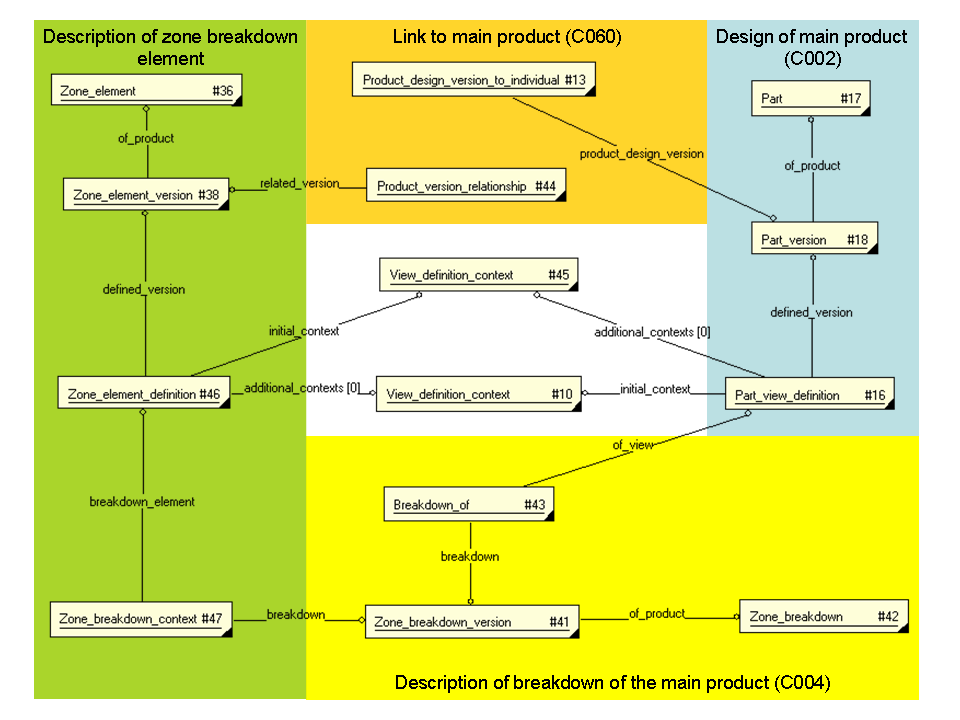
| Business DEX (NDLO006):— product_breakdown_structure | Date: 2007/10/12 12:27:18 Revision: 1.38 |
Purpose
This NDLO-DEX shall enable the exchange of data about system/product breakdown structures and their elements. The data are input for configuration management and for engineering, risk, and logistics analysis with focus on requirements allocation and system design, and planning and conduct of support.
Usage
This NDLO-DEX provides input data to manage product risk and configuration through life, for requirements definition and analysis, for architectural design assessment, for maintenance scheduling and resource planning and allocation.
This section provides an overview of the business DEXs.
Zone breakdown
Zone breakdowns are briefly described in the section "Terms".
The figure below describes the zone breakdown of a product. It is divided into several different areas. The number in the parenthesis indicates the capability that is described by the entities in the rectangle.

Block breakdown
The figure below describes the block breakdown of a product. It is divided into several different areas. The number in the parenthesis indicates the capability that is described by the entities in the rectangle.
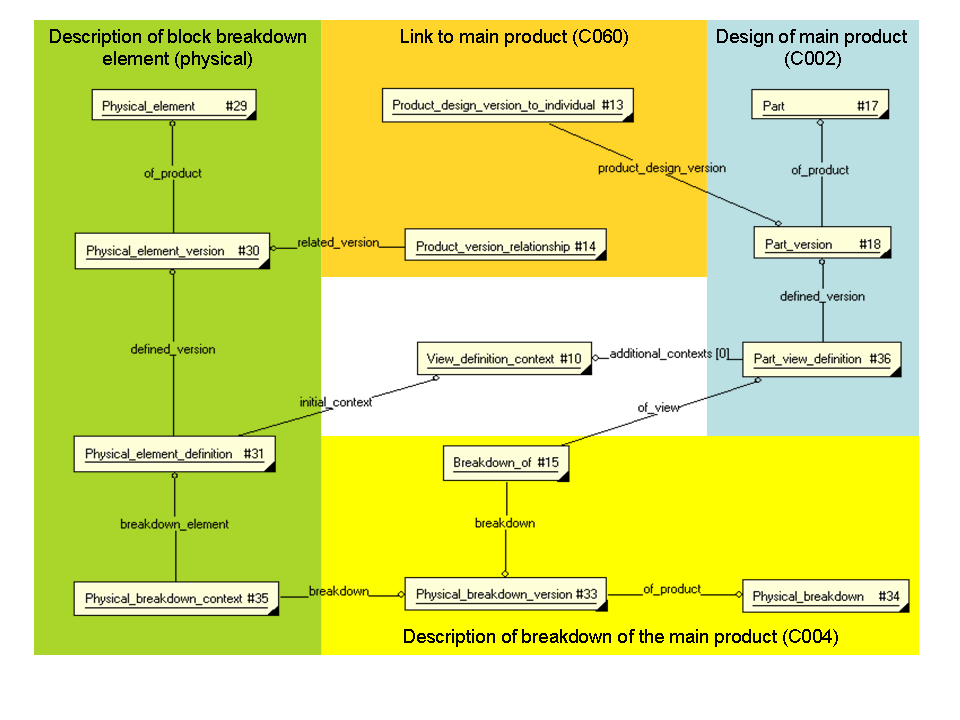
Module breakdown
The figure below describes the block breakdown of a product. It is divided into several different areas. The number in the parenthesis indicates the capability that is described by the entities in the rectangle.

Work breakdown
A work breakdown structure is a functional decomposition from the project viewpoint of the tasks that are required for a program of work to be a success. It is a means of organizing system development activities based on system and product decompositions. The prime use of the WBS is the design and tracking of work. The WBS is used to establish what work is necessary, a logical decomposition down to work packages and a method of organizing feedback. Work breakdowns may or may not coincide with other types of breakdowns.
The figure below shows the work breakdown structure (WBS) of a product, which is used to enable budgeting, maintenance planning and cost follow-up. The main product is divided into elements, on which costs related to for example maintenance will be registered. The aim of the business function is to link work breakdown elements (in this case functional elements such as propulsion) to an individual parent product. This parent product is in turn linked to a specific design.
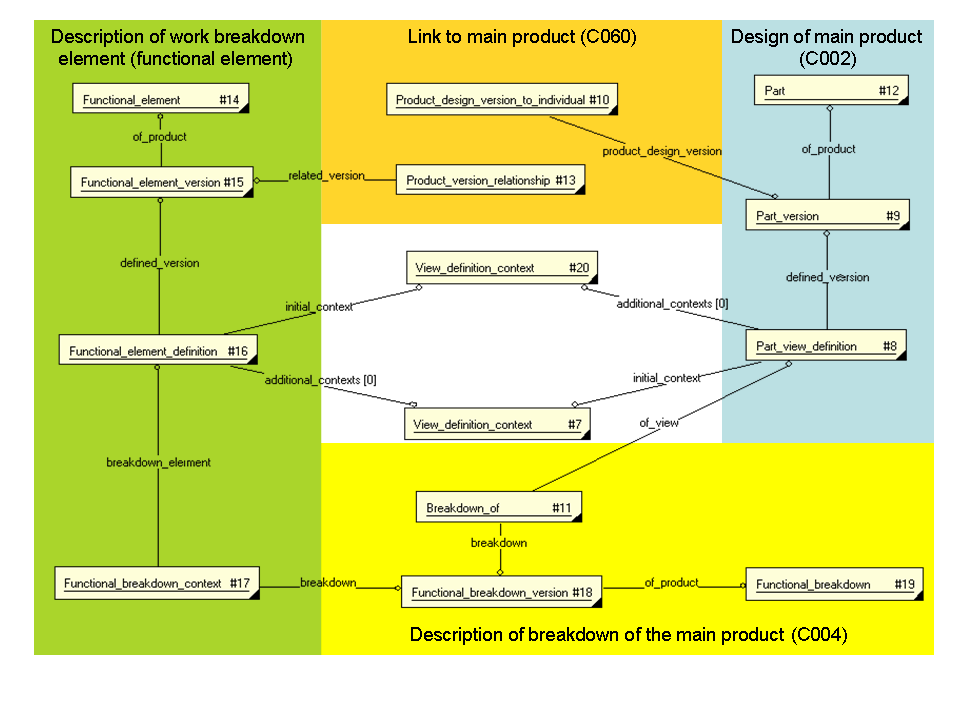
Configuration item
Configuration items identify all configurable items on a ship.
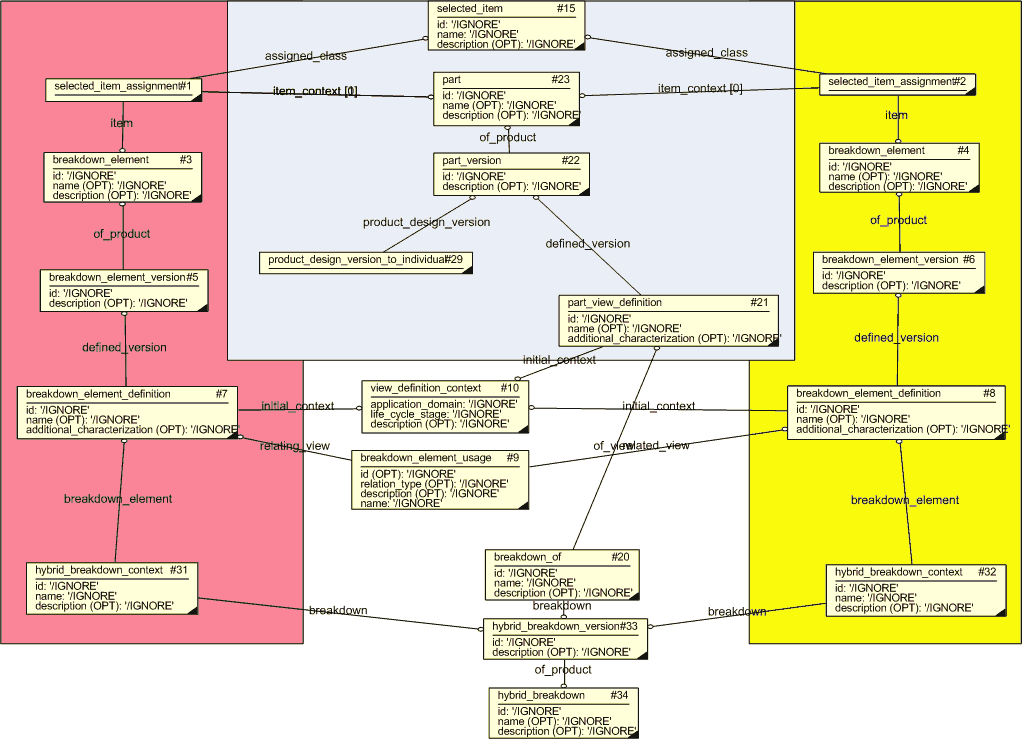
Breakdown element realisation
The figure below shows how a breakdown element is realised using physical parts. The blue rectangle on the left side in the figure contains entities describing the breakdown element, whereas the entities in the green rectangle to the right describe the part or parts which are the realisation of the element. Finally, the entity in the orange rectangle describe how the breakdown element is linked to a specific product.
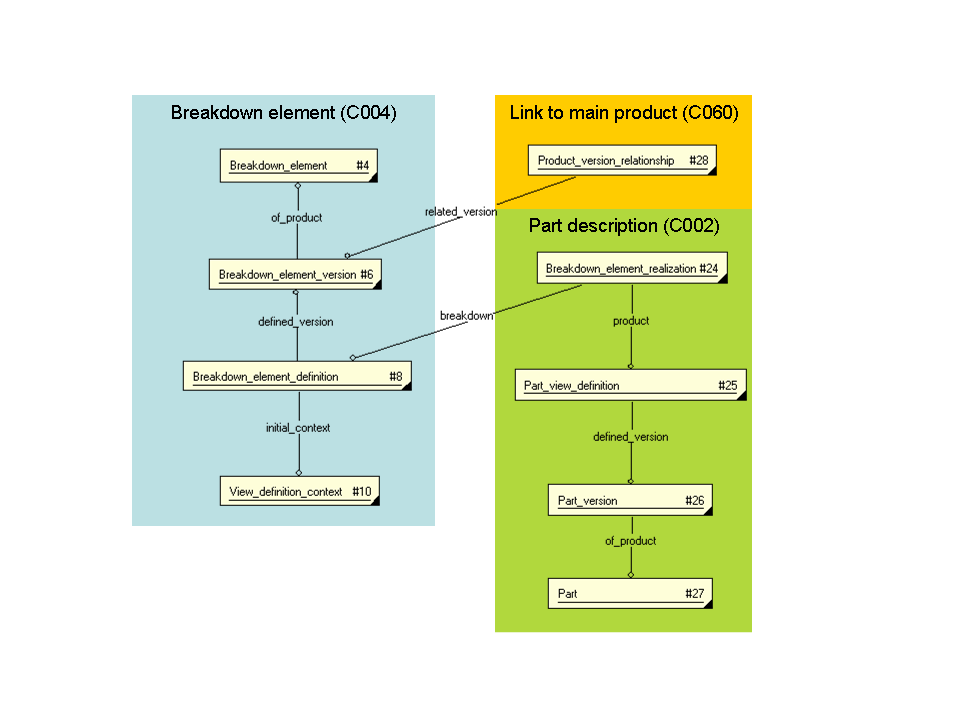
This NDLO-DEX is divided into several business DEXs, each supporting various business functions. The table below indicates which functions are available in the different business DEXs. An "x" in the table means that the function is available for the business DEX in question. The following appreviations are used Zone breakdown=Z, Block breakdown=B, Module breakdown=M, Work breakdown=W, Configuration item=C, Breakdown element realisation=BER
|
Business function id |
Business function description |
Business constraints |
Z |
B |
M |
W |
C |
BER |
|---|---|---|---|---|---|---|---|---|
| 1 | Identify organization that assigned an identifier to a part | This is a mandatory data item for all identifiers. | x | x | x | x | x | x |
| 1.1 | cont | There shall be only one instance of the class for an organization | x | x | x | x | x | x |
| 1.2 | cont | There shall be only one instance of the class for an organization | x | x | x | x | x | x |
| 2 | Identify the life cycle stage for which the data are valid | There shall be no more than one class instance for one instance of part_view_definition. | ||||||
| 2.1 | Identify the life cycle stage to be the support stage | There shall be no more than one class instance for one instance of part_view_definition. | x | - | - | x | x | x |
| 2.2 | Identify the life cycle stage to be the production stage | There shall be no more than one class instance for one instance of part_view_definition. | x | x | x | x | - | - |
| 3 | Identify the application domain for which the data are valid | There shall be no more than one class instance for one instance of part_view_definition. | x | x | x | x | x | x |
| 4 | Represent breakdown | Instantiate as in #4.x | ||||||
| 4.1 | Classify breakdown as configuration item breakdown | - | - | - | - | x | - | |
| 4.2 | Classify breakdown as part work breakdown structure | - | - | - | x | - | - | |
| 4.3 | Classify breakdown as part module breakdown structure | - | - | x | - | - | - | |
| 4.4 | Classify breakdown as part block breakdown structure | - | x | - | - | - | - | |
| 4.5 | Classify breakdown as part zone breakdown structure | x | - | - | - | - | - | |
| 5 | Identify breakdown structure | This identification applies to any type of breakdown in step #4. The identification is optional. If not present, the classification of the breakdown needs to be unique in a given data population. | x | x | x | x | x | - |
| 6 | Identify version of breakdown structure | Instantiate as subtype of Breakdown_version in accordance with the selected subtype in #4. | x | x | x | x | x | - |
| 7 | Identify breakdown element | Instantiate as in #7.x.A Breakdown_element shall be assigned only one such identification code. | ||||||
| 7.1 | Identify configuration item | Breakdown_element may be instantiated as Functional, Physical, System, or Zone_element.There shall be at least one Breakdown_element_definition for this Breakdown_element and this according to #2.1 and #3.The Breakdown_element shall be referenced by a Selected_item_assignment that is classed as Configuration_item_identification. | - | - | - | - | x | x |
| 7.2 | Identify part module breakdown element | There shall be at least one Physical_element_definition for this Physical_element and this according to #2.2 and #3. | - | - | x | - | - | - |
| 7.3 | Identify part work breakdown element | There shall be at least one Functional_element_definition for this Functional_element and this according to #2.2 (initial_context), #2.1 (additional_context) and #3 (for both). | - | - | - | x | - | - |
| 7.4 | Identify part block breakdown element | There shall be at least one Physical_element_definition for this Physical_element and this according to #2.2 and #3. | - | x | - | - | - | - |
| 7.5 | Identify part zone breakdown element | There shall be at least one Zone_element_definition for this Zone_element and this according to #2.2 (initial_context), #2.1 (additional_context) and #3 (for both). | x | - | - | - | - | - |
| 8 | Give name to breakdown element | Instantiate as in #8.x | ||||||
| 8.1 | Give name to configuration item | Same constraint applies as in #7.1 . | - | - | - | - | x | - |
| 8.2 | Give name to part work breakdown element | - | - | - | x | - | - | |
| 8.3 | Give name to module | - | - | x | - | - | - | |
| 8.4 | Give name to block | - | x | - | - | - | - | |
| 8.5 | Give name to zone | x | - | - | - | - | - | |
| 9 | Identify version of breakdown element | Breakdown_element_version shall be instantiated as one of its subtypes and in accordance to the selected subtype in #8.x .There shall be at least one Breakdown_element_definition for a Breakdown_element_version. | x | x | x | x | x | x |
| 9.1 | Classify the representation of the description | This is an optional data item | - | - | - | - | x | - |
| 9.3 | Give description to configuration item | This attribute shall be assigned to the appropriate subtype of Breakdown_element as selected in #7.1 .(The class_name may in the future be replaced by its superclass: Breakdown_element_code_description.) | - | - | - | - | x | - |
| 9.4 | Classify the document for a configuration item description | This is an optional data item | - | - | - | - | x | - |
| 10 | Identify breakdown element as configuration item | Selected_item_assignment shall reference a Part with id-type 'Owner_part_number' as item_context. | - | - | - | - | x | - |
| 11 | Collect configuration items | - | - | - | - | x | - | |
| 12 | Enable breakdown elements to be in many-to-many relationships (e.g. parent/child) | Children are in Breakdown_element_usage.related_view, parents in Breakdown_element_usage.relating_view.Instantiate Breakdown_element_usage as one of its subtypes as appropriate according to selection in #7.x . | - | - | - | - | x | - |
| 13 | Identify the type of relationship between breakdown elements | R1: Instantiate Breakdown_element_usage as one of its subtypes as appropriate according to selection in #7.x . R2: A DEX shall contain only one instance of breakdown_element that does not have the role of .related_view. | - | - | - | - | x | - |
| 14 | Identify quantity of alike children to a parent breakdown element | Instantiate Breakdown_element_usage as one of its subtypes as appropriate according to selection in #7.x . | - | - | - | - | x | - |
| 14.1 | Classify the representation of the quantity value | There will be no more than one class instance for one instance of the value_component. | - | - | - | - | x | - |
| 14.2 | Identify unit of measure for a quantity | C079 context_dependent_unit.si_unit='f' | - | - | - | - | x | - |
| 15 | Identify importance of configuration item for parent assembly operation | Assign property to #7.Instantiate as subtype of Breakdown_element_definition according to selection in #7.1 .The Breakdown_element_definition subtype shall use #2.1 and #3. | - | - | - | - | x | - |
| 15.1 | Classify the name of criticality | There will be no more than one class instance for one instance of the value_component. | - | - | - | - | x | - |
| 15.2 | Classify the criticality code | There will be no more than one class instance for one instance of the value_component. | - | - | - | - | x | x |
| 15.3 | Assign a Encoding system document to the name of the assigned property | There shall be zero or one instance for one instance of #15 | - | - | - | - | x | x |
| 15.4 | Identify the document version number | - | - | - | - | x | x | |
| 15.5 | Identify the document that describes the encoding system | The class instance relates to Step #15.3. | - | - | - | - | x | x |
| 15.6 | Identify document number | There shall only be one instance for one instance of Step #15.5 | - | - | - | - | x | x |
| 16 | Assign a breakdown element to a breakdown | use the mappings in #16.x | ||||||
| 16.1 | Assign configuration items to a configuration item breakdown | - | - | - | - | x | - | |
| 16.2 | Assign part work breakdown elements to a part work breakdown structure | - | - | - | x | - | - | |
| 16.3 | Assign module breakdown elements to a part module breakdown structure | - | - | x | - | - | - | |
| 16.4 | Assign block breakdown elements to a part block breakdown structure | - | x | - | - | - | - | |
| 16.5 | Assign zone breakdown elements to a part zone breakdown structure | x | - | - | - | - | - | |
| 17 | Assign requirement for annual operating hours to configuration item | Assign property to #7.Instantiate as subtype of Breakdown_element_definition according to selection in #7.1 .The Breakdown_element_definition subtype shall use #2.1 and #3. | - | - | - | - | x | - |
| 17.1 | Identify hours as unit of measure for time based properties | Unit.si_unit='f'. There is one Time_unit instance for one Part_view_definition instance. | - | - | - | - | x | - |
| 18 | Categorize a configfuration item e.g. as hardware or software | Instantiate as subtype of Breakdown_element_definition according to selection in #7.1 . | - | - | - | - | x | - |
| 19 | Assign control requirements to configuration item | Assign property to #7.Instantiate as subtype of Breakdown_element_definition according to selection in #7.1 .The Breakdown_element_definition subtype shall use #2.1 and #3. | - | - | - | - | x | x |
| 19.1 | Classify the name of criticality | There will be one class instance for one instance of #19.2. | - | - | - | - | x | - |
| 19.2 | Classify the criticality code | There will be one class instance for one instance of #19.2. | - | - | - | - | x | - |
| 19.3 | Classify the representation of the string value | There will be no more than one class instance for one instance of the value_component. | - | - | - | - | x | - |
| 20 | Assign parts as occurrences of breakdown elements | Instantiate only as #20.x .Add more subclasses for Breakdown_element_realization as required. | ||||||
| 20.1 | Assign parts as occurrences of configuration items | Not all CIs (Breakdown_element) have an APL (i.e., a link via a Breakdown_element_realization to a Part_view_definition).Each CI has maximum one APL. | - | - | - | - | x | - |
| 21 | Identify the location of a breakdown element in the context of the product that it is installed in | Apply #22 to relate location to Breakdown_element. | - | - | - | - | - | - |
| 21.1 | Identify the location of a breakdown element in the context of the product that it is installed in | Apply #22 to relate location to Breakdown_element. | - | - | - | - | - | - |
| 22 | Classify the location relationship of a breakdown element | Instantiate only as #22.x .Add more subclasses for Product_based_location_identification as required. | ||||||
| 22.1 | Classify the location relationship of a configuration item | There shall be only one instance of the class for an In_zone instance. | - | - | - | - | - | - |
| 23 | Define a product context for a breakdown structure | Links #6 to the relevant Part_view_definition of #40 | x | x | x | x | x | - |
| 34 | Identify the document that describes location codes | - | - | - | - | - | - | |
| 35 | Identify the version of the document that describes location codes | Relates to #34. | - | - | - | - | - | - |
| 36 | Relate location codes to the version of a document that describes them | Links #21 to #35. | - | - | - | - | - | - |
| 37 | Identify the individual product that is the context for identification of a location | This Product_as_realized is referenced by the item in #21. | x | x | x | x | x | - |
| 37.1 | Identify the version of the individual parent part | Relates to #37.Applies to Step #1 instances. If "exchange_data" not set, insert value '000.00' as required by S1000D. Each instance value is a key to identify the part_version, and shall be unique for a part. | x | x | x | x | x | x |
| 38 | Link breakdown element to the indivdual product that they describe a view of | This shall be used for all types of Breakdown_elements. | x | x | x | x | x | - |
| 39 | Relate the individual product that has a breakdown structure to the design of the product | This shall relate Product_as_realized to Part_version. | x | x | x | x | x | - |
| 40 | Identify the version of the design of the individual part | Relates to #41.Step #1 applies. If "exchange_data" not set, insert value '000.00' as required by S1000D. Each instance value is a key to identify the part_version, and shall be unique for a part.There shall be at least one Part_view_definition and that shall use #2.1 as initial_context, #2.2 as additional_contexts - if one of the breakdown_elements in #7.x uses #2.2 - and #3 for both. | x | x | x | x | x | x |
| 41 | Identify the design of the individual part | An instance relates to instances of Steps #10 and 37. There shall be zero, one or more instances for an instance of Step #37. | x | x | x | x | x | - |
| 42 | Provide item designator as part type identifier, as alternative to e.g. OEM part type code | An instance relates to an instance of Step #20.1. There shall be zero or one instance for an instance of Step #20.1. There shall be zero, one or more instances for one instance of the Part entity. | - | - | - | - | - | x |
Table 0 — Business functions present in different business DEXs
Model rules - zone breakdown
Model rules - block breakdown
Model rules - module breakdown
Model rules - work breakdown
Model rules - Configuration item
Model rules - breakdown element realisation
© OASIS 2010 — All rights reserved